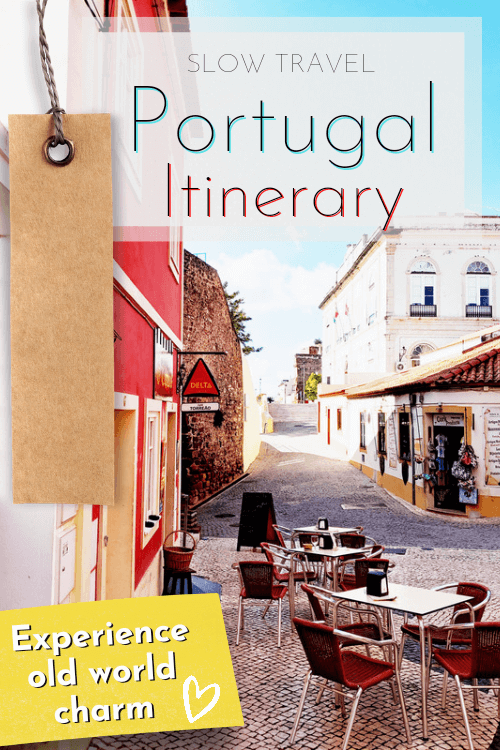Sintra is one of our favourite places, and Quinta da Regaleira is our top pick in Sintra.
This little slice of paradise has a bit of everything: Mystery, nature, architecture, and even afternoon tea!
Read on for a deep dive on this eccentric bucket list spot, plus tips for your visit!

The Mysterious Initiation Well at Quinta da Regaleira
Quinta da Regaleira’s “Initiation Well” or “poço iniciático” is so famous that sometimes people just refer to the well itself as “Quinta da Regaleira” not realizing that there is an entire Gothic mansion and huge estate in the same place.
If you’ve been Googling the property, it’s probably because you saw pictures of the well first!

What is Portugal’s Famous Initiation Well?
If you haven’t seen it, the well is a deep spiral staircase descending underground to a tunnel. The stone staircase is hollow in the centre with a patterned floor at the bottom.
From above, the entrance to the staircase is disguised as an innocuous pile of rocks.
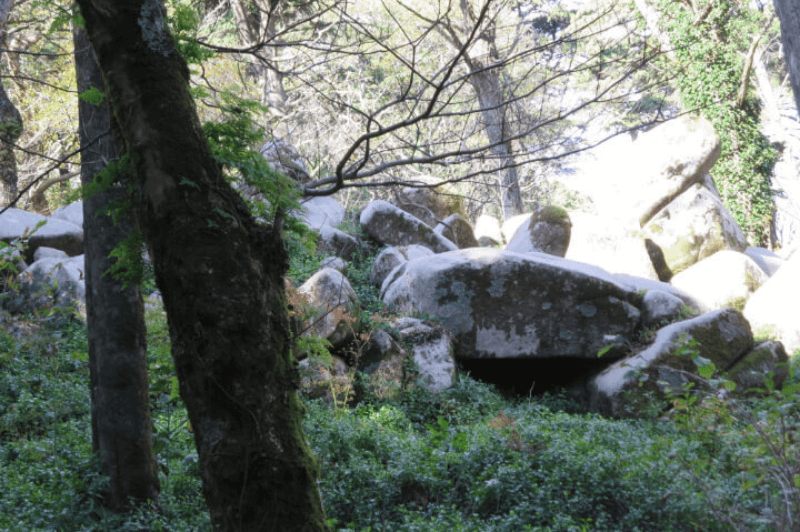
The official Quinta da Regaleira visitors’ brochure describes the well as:
“A ‘subterranean tower’ that sinks some 27 metres into the earth. Made accessible by a monumental spiral stairway, this hallowed space, full of esoteric and alchemical associations, makes the relation between Heaven and Earth intensely felt.”
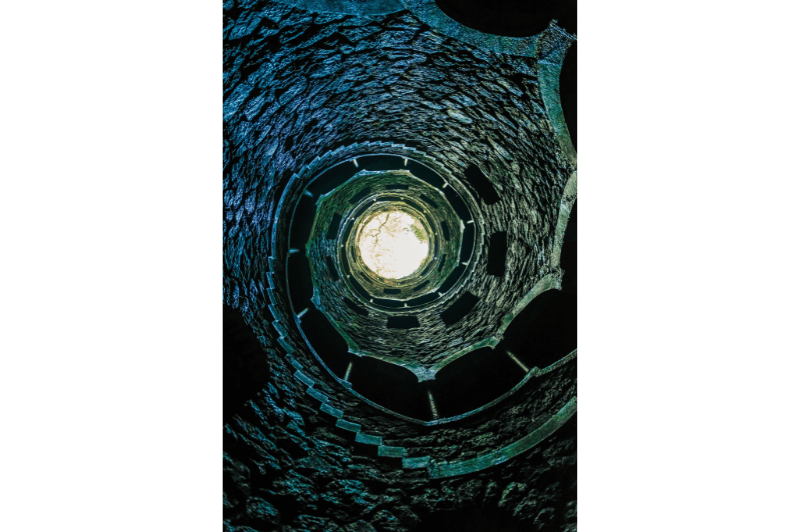
Visiting the Initiation Well
The Initiation Well is quite far from the main house and near the edge of the estate.
You used to be able to access the well from the tunnels below, but it became too crowded and now you can only enter from above.

The well is so popular that there is a spot to queue at the top and a staff member managing the flow of traffic.
There is also a “no stopping” rule on the way down, but of course everybody does briefly, to get a few photos.
Best Time to See the Initiation Well
It is still well worth visiting the Initiation Well, but it’s considerably less mystical when crushed into a staircase with a hundred other people while someone barks at you not to stop.

If you want better pictures of the well, be at the estate as soon as it opens and head straight for the well. You might also try your luck after closing, because you can stay on the grounds for one hour after last entry.
Who Built The Initiation Well
Antonio Monteiro had the Initiation Well built to the designs of Luigi Manini at the same time the rest of the house and grounds were constructed.

Why is it Called the Initiation Well
I did a lot of digging and can only assume that when the municipality purchased the property in 1997 with the intent to make it public, that they named all of the points of interest for a map.
Now labelled on the visitors’ map as “The Initiatic Well”, that became the name that everybody uses.
The mysterious spiralling well has a pink compass printed on the floor, and that, plus the fact that there is no obvious purpose for the well in the first place, led people to speculate about the occult.
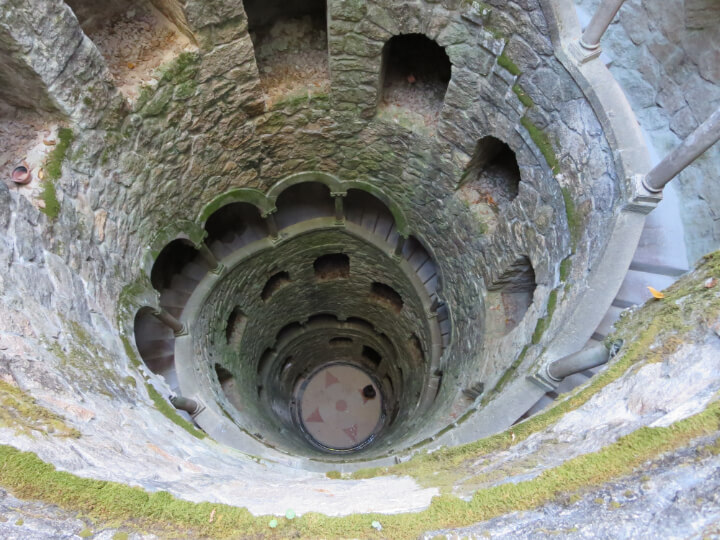
What was the Initiation Well Used For?
This BBC article suggests:
Templar initiations at Quinta da Regaleira began with candidates entering one of the Initiation Wells blindfolded. Holding a sword close to their heart, they would descend nine flights of stairs – a number that represents the nine founders of the Templar order.
Once reaching the bottom of the well, the candidate would walk into a dark labyrinth where they would symbolically and literally find their way up towards the light.
If they were able to make back through the well tower and into the sunlight, initiates would walk across stones in water to reach the chapel, where they would then be welcomed into the brotherhood.
As interesting and mysterious as this explanation is, it is sheer speculation.
I wish there were some sources because I would love to know if any of the Knights Templar rumors are true.
[Bear with me for an update below]
The sceptic in me doubts the story.
First of all, if one has to find their way back to the light from the labyrinth, that implies these rituals were done in the daytime, which seems very odd.
(Although I suppose a full moon could always be involved.)
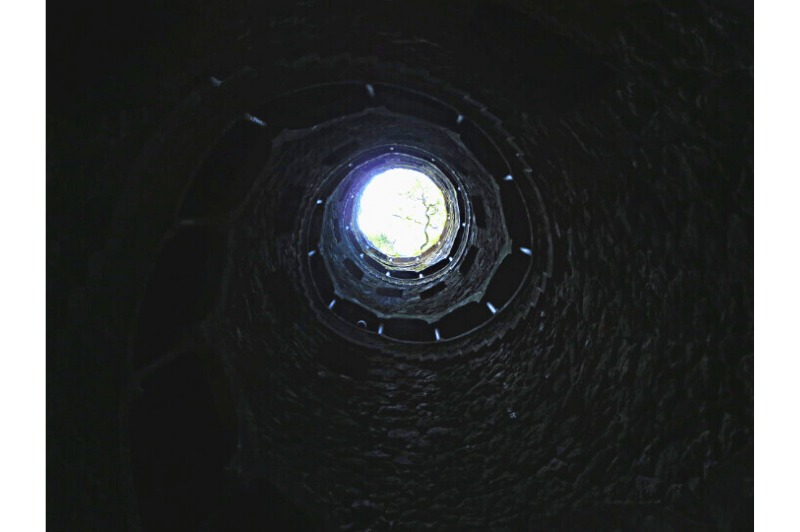
Secondly, while there are a few tunnels, I don’t think anyone would fail this challenge. There are only so many places to go.
(Then again, if someone had made it this far into the recruitment process, they kind of need to make the initiation foolproof. They can’t risk being exposed because they had to reject a nincompoop who couldn’t find his way out of their friend Antonio’s backyard tunnel.)
Finally, the chapel is a good ways away from the stepping stones in the pond, so it seems like an attempt to tie it together. Why not mention all the other structures in between?
It’s a small thing, but it drives me absolutely bananas when one person states something as fact with absolutely no evidence and then others repeat it until it’s true.
The Wikipedia article for Quinta da Regaleira even states that the well was “used for ceremonial purposes that included Tarot initiation rites.” There is zero grounds for this claim, nor are there any sources cited.
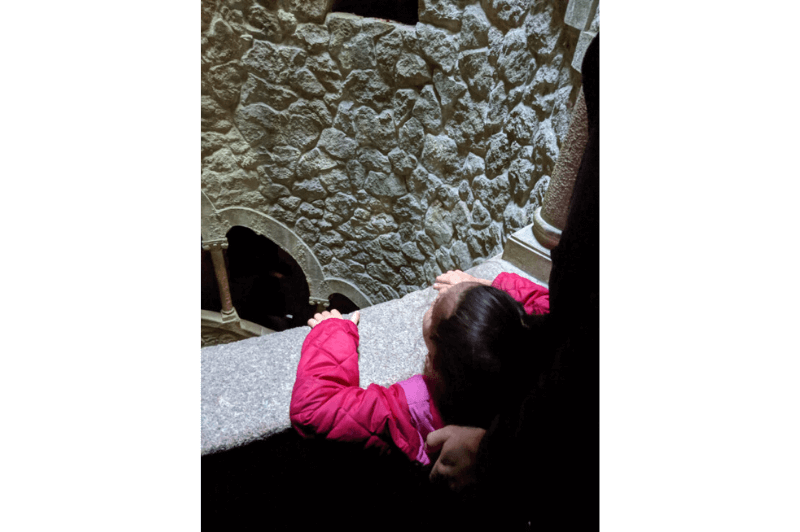
Here’s yet another explanation about the well:
“One of the most incredible places in Regaleira is the Initiation Well. The spiral staircase consists of nine levels separated by flights of 14 steps each, invoking references to Dante’s Divine Comedy (9 circles of Hell, Paradise and Purgatory) and the women’s fertile period usually starting at half of the 28 days lunar calendar.”
In that last article, the author even calls Monteiro “one of the most influential Freemasons in Portugal at the time.” Well that’s audacious…
Another piece I read referred to Monteiro as a “well-known Freemason.”
More about the eccentric owner of Quinta da Regaleira in a moment, but first the basics about the property:
Where is Quinta Da Regaleira and What Was it Used For?
Quinta Da Regaleira is located in the town of Sintra, Portugal.
Sintra is a short train ride outside of Lisbon (about 45 minutes) and the whole area is a UNESCO World Heritage Site.
Quinta Da Regaleira is often described as one of Sintra’s many castles, but it is actually a private mansion (now owned by the municipality) and not as old as it appears!
The word “Quinta” means “villa” and the mansion served as a private home until 1987.
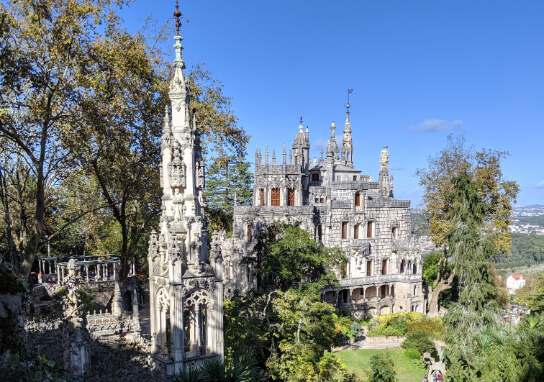
When Was Quinta Da Regaleira Built?
The current house was built in the Gothic Manueline style popular in Portugal during the 16th century, but it was actually constructed between 1904 and 1911.
Quinta da Regaleira is still named after a previous owner: The Baroness da Regaleira.
When the Baroness owned the property in the mid to late 1840’s it was her summer retreat. There was a mansion and chapel on the grounds, but not the same ones that stand today.
Quinta da Regaleira was sold at auction in 1893 to Antonio Augusto de Carvalho Monteiro, the mastermind who would turn it into the magical place that it is today. Monteiro added several adjoining parcels of land to create the large grounds of the estate.
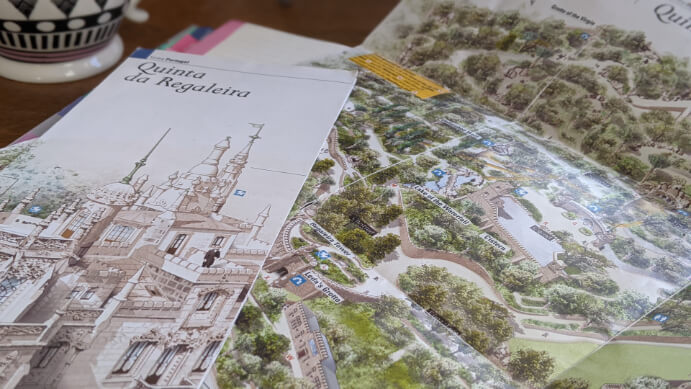
Work began on the gardens and coach houses in 1898, with the help of Italian architect and designer Luigi Manini. The villa and gardens were completed in 1912.
About Quinta da Regaleira’s Owner
Antonio Augusto de Carvalho Monteiro was born in Brazil in 1848 to Portuguese parents, during a time when Portugal still ruled that country.
How was Monteiro Wealthy?
Wealth begets wealth, and although “Monteiro the Millionaire” became a successful merchant, he was the proud beneficiary of a large family fortune.
Why the Elaborate Gardens?
Monteiro was an entomologist (a person who studies bugs) and a very enthusiastic one.

While nobody really needs a reason to enjoy a beautiful garden, Monteiro was fascinated by butterflies, and had an extensive collection of butterflies, moths, and other insects.
It makes sense that he wanted to create an amazing outdoor haven for himself and his little friends.
Was Monteiro a Freemason?
There is no definitive proof that Monteiro was a Freemason.
He was said to be fascinated with the Knights Templar, as well as various forms of mythology. There are masonic references in Quinta da Regaleira’s grounds, and on his tomb (also designed by Manini).
I tried to find out why he is so often labelled a Freemason (reasons beyond the internet being an echo chamber) but all I could find was the architectural references.
I’m no genius, but surely someone who is part of a secret society wouldn’t give himself away by building elaborate monuments?
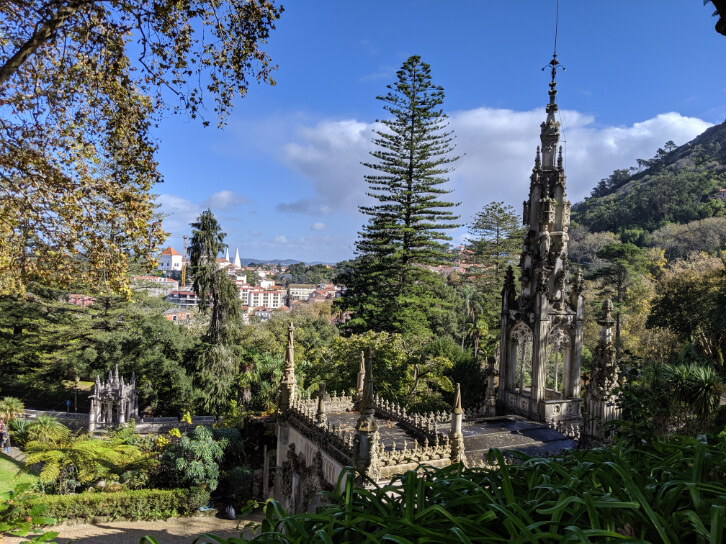
Monteiro clearly embraced a number of architectural styles and mystical ideas.
He built the house and chapel in a Gothic Manueline style, other structures on the grounds are a simpler medieval style, and there is even the “Promenade of the Gods” – a walkway lined with greco-roman mythological statues.
I personally think he just liked a bit of mystery.
Antonio Augusto de Carvalho Monteiro Death
Quinta da Regaleira’s inspired owner died in 1920 in his early 70s, just 8 years after the completion of his project. The property wasn’t sold until 1987 so I assume it stayed in the family until then.
Monteiro was buried in Lisbon’s prestigious Prazeres Cemetery. You can see pictures of his elaborate tomb designed by Luigi Manini here.

Best Time to Visit
The best time to visit Sintra, and Quinta da Regaleira, is in the Spring or Fall.
Sintra has become one of the most popular tourist destinations in Portugal and can be extremely crowded in the Summer.
Try to visit first thing in the morning or a couple hours before close. You will need at least two hours for your visit to Quinta da Regaleira. There is so much to see!
Try to spend at least two full days in Sintra, or you will miss out on some amazing sites. Three days would be more comfortable.
You cannot see everything in Sintra in a day trip, and compared to the tourist attractions in Lisbon, your time is better spent in Sintra.
Here is a post with tips to avoid the crush of Sintra’s crowds.
Off Season Weather
Sintra is in the hills, and a fair bit wetter than it’s nearby friend Lisbon. If you visit in the fall, do bring an umbrella, and a waterproof coat and shoes.
Getting to Quinta da Regaleira
Quinta da Regaleira is one of the easier attractions to get to in Sintra. You can actually walk from the town centre, and it is fairly flat.

Arriving in Sintra by train from Lisbon is only a 45 – 50 minute journey.
This makes it easy to spend more than one day in Sintra if you want to, and still enjoy the nightlife of Lisbon.
You can walk from the train station down the hill and along a winding road to the old town. From the old town, the walk to Quinta da Regaleira is another 15 – 20 minutes (taking your time).
You can also catch a hop on hop off bus near the tourist information centre, but in this case walking is better.
You will arrive separate from the crowds on the bus, and the walk is very interesting, taking you past Sintra’s historical homes and beautiful roadside fountains.
Tickets to Quinta da Regaleira
You can buy tickets when you arrive at Quinta da Regaleira, or online here.
You can also buy them at Sintra’s tourist information centre in the old town near the National Palace.
Ticket Prices
Under 5: Free
Youth [6 – 17]: 5 Euros (~$5.80 USD)
Adults [18+]: 10 Euros (~$11.60 USD)
Seniors [65+]: 5 Euros (~$5.80 USD)
Senior Plus [80+]: Free
Masonic References at Quinta da Regaleira
[An update about the Knights Templar and my quest for the truth. Dramatic, I know.]
I have visited Quinta da Regaleira twice, which was all I was thinking about when I started writing this post.
Then I started getting worked up over the lack of confirmed information out there regarding Monteiro’s alleged association with the Freemasons.
I finally found a well-researched article WITH sources and I thought I would share the information:
During all this time of investigation, there were many working hypotheses, but the conclusions finally reached (…) indicate that Quinta da Regaleira is, essentially, a product from the historical period of its construction, representing a mythical vision of Portugal in contrast to the serious difficulties the country was going through at the time, without any historical relationship with orders or initiatory ways.
In short, Quinta da Regaleira was built as an escape from reality.
In particular, we cannot fail to emphasize clearly that there is no record of neo-Templar activity in Portugal in the historical period that matters to us, when we study the Regaleira.
Well that’s pretty clear.
Kind of rules out the idea that Monteiro was “the most influential Freemason in Portugal” at the time.
Or does it? Since there were precisely zero of them.
I guess it could be easy to be the most influential at something that doesn’t exist.
Therefore, we do not know any scientifically valid reasoning that could relate Regaleira to esoteric or initiatory ways, and Carvalho Monteiro’s lack of connection with Freemasonry is absolutely evident, at least in Portugal and, particularly, at the time of the building of the farm.
It’s fun that the estate translated to “farm” though!
Other Things to See at Quinta da Regaleira
Portal of the Guardians
Portal of the Guardians is a stone wall with two spiral staircase towers above it. Below the wall is an entrance towards the Initiation Well, but sadly the well is one-way only now, due to crowding.
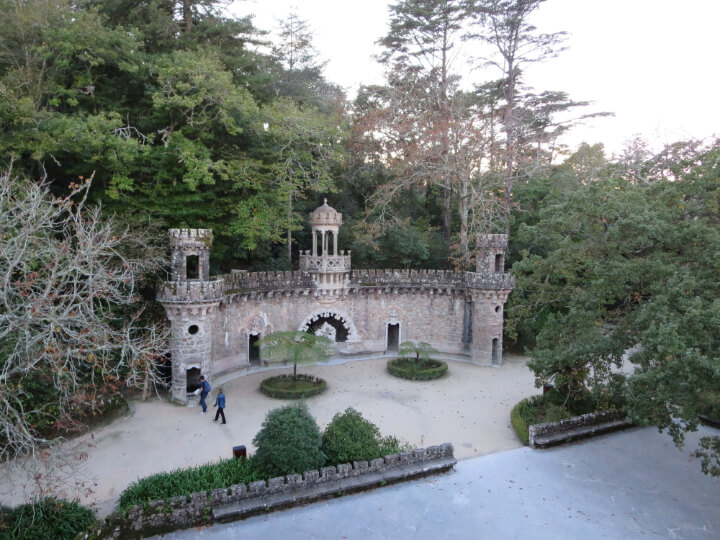
The first time I visited Sintra you could go through all of the tunnels and travel any direction, but the popularity of Quinta da Regaleira and Sintra has exploded since then.
Regardless, the towers are another fun thing to climb around on and explore.
Pisoes Loggia
If you walk to Quinta da Regaleira, you will pass the gated Pisoes Loggia at the street level.
Once inside the walls, it’s easy to miss. Make your way back along the roadside wall from above to the furthest corner.
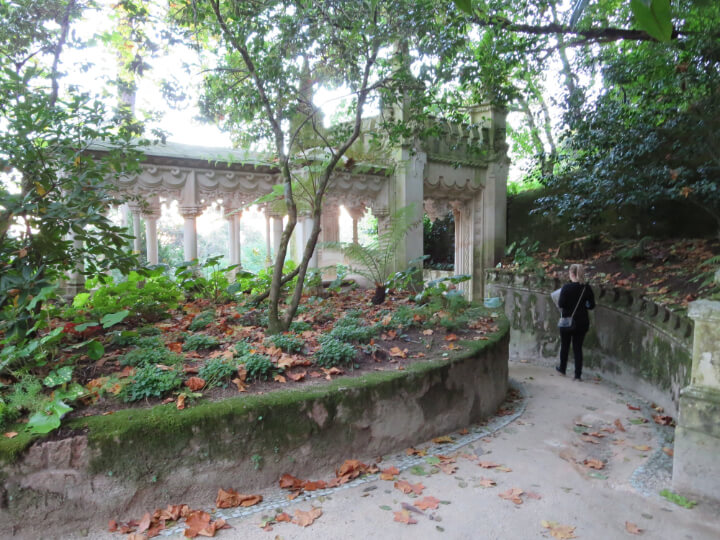
It’s a bold statement, but this may be one of the best places to take pictures of the blue and white tile in Portugal.
(Although there are a couple great spots in Porto too!)

Inside the sheltered Gothic structure, surrounded by greenery, the tile pops against the nature that is seemingly trying to reclaim the space.
Promenade of the Gods
On your way to Pisoes Loggia, following the stone wall, you will walk through Promenade of the Gods. This is a portion of the main walkway that is lined with statues of classical gods from greco-roman mythology.

Leda’s Grotto and Regaleira Tower
Leda’s Grotto is a covered fountain area nestled into a stone wall.

Regaleira Tower is on the wall above Leda’s Grotto and provides an amazing view of the main house and grounds.
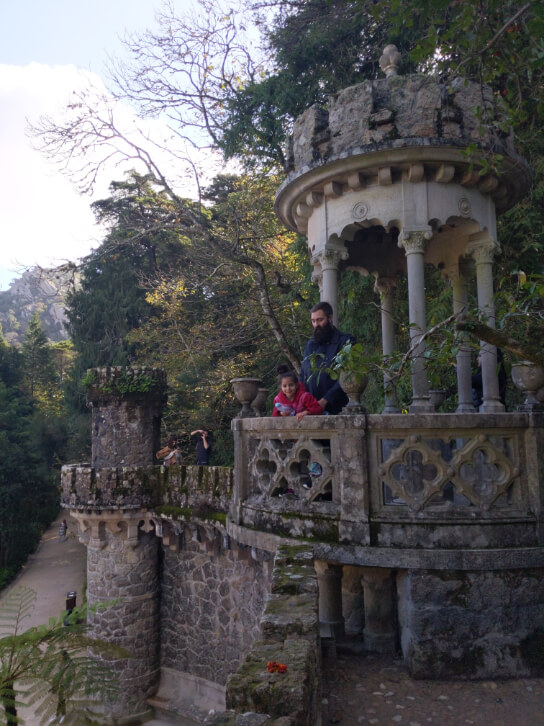
Lake of the Waterfall
One of my favourite spots at Quinta da Regaleira is the Lake of the Waterfall, with it’s bright green waters, stepping stones, and even a bridge overhead. Behind the pond are secret caves, ripe for exploring.

Chapel
The chapel at Quinta da Regaleira is built in a similar Manueline style to the main house. It is tiny, so takes no time at all to look inside. You can only walk into the doorway and not much further.
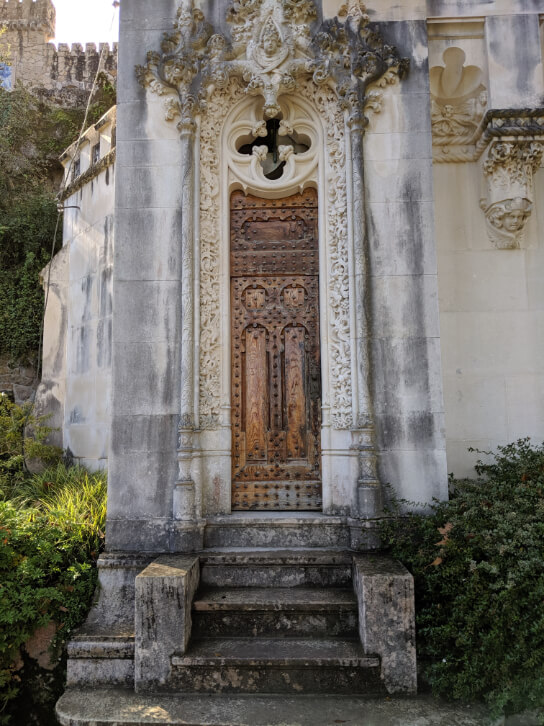
The chapel is a very nice little church to take photos of. It has a magical overgrown sort of aesthetic.
Greenhouse
The greenhouse at Quinta da Regaleira doesn’t get much attention amongst all the other amazing and famous things to see, but it is beautiful and a quiet place to stop.
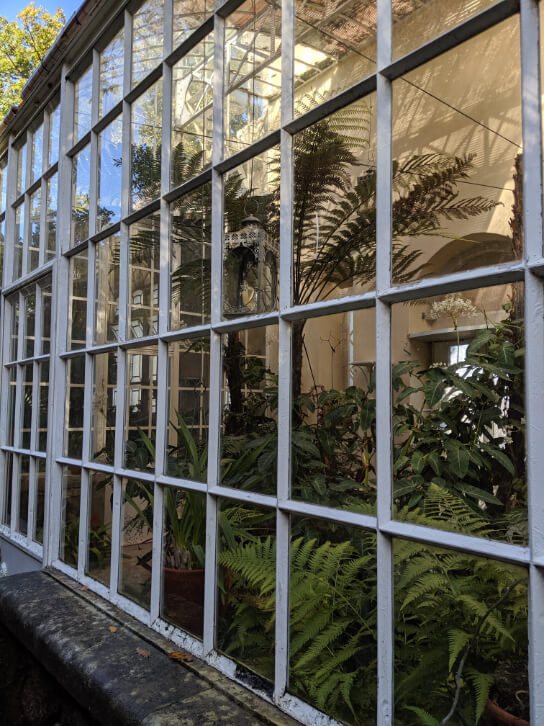
You can’t enter the greenhouse, but the narrow walkway around the back will take you past all of the glass walls that look into plant heaven.
Cafe (Chimera’s Court)
If I was to vote for my favourite cafe in Europe, the cafe at Quinta da Regaleira would get my vote.

Tucked into a corner behind the main house and against the stone wall that lines the road, is an open patio area where you can have coffee and a snack.
From your chair you can enjoy the views of a Gothic manor, spectacular gardens as far as the eye can see, and over the wall is a forest of trees.
It really is picture perfect. I have no idea what anything tasted like, it was that glorious.

Bonus: It wasn’t ridiculously expensive.
Quinta da Regaleira Mansion
The main house of Quinta da Regaleira is exceptionally beautiful from the outside, and just moderately interesting inside.
The rooms are actually quite plain in comparison to everything else going on at the property.
You can’t go through the whole house, but a decent amount is open to the public. You only need to spend 15 – 20 minutes total indoors at Quinta da Regaleira.
I would start a visit at Quinta by seeing the house, (if you aren’t rushing to the well) because if you save it for the grand finale, you will be disappointed.
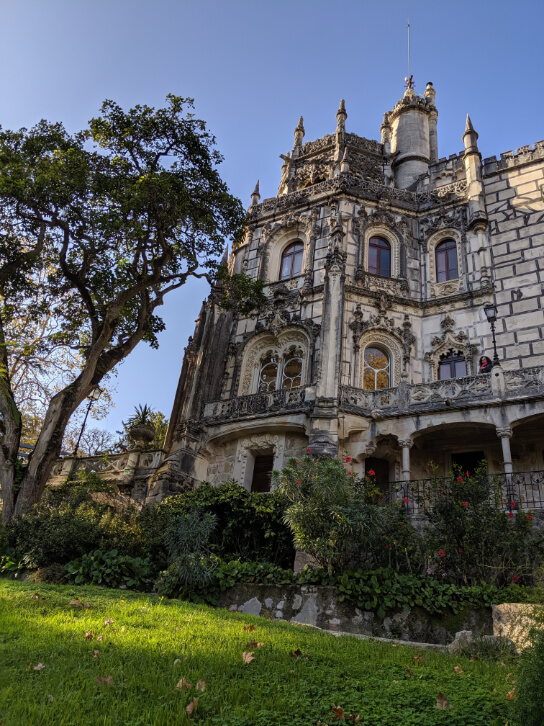
Quinta da Regaleira Fun Fact
In 1987 when the property was finally sold by Monteiro’s family, it was purchased by a Japanese company named Aoki. It was never opened to the public or lived in during this time.
Why?
Just another Quinta da Regaleira mystery.
If it was this Aoki, I wonder if they had planned to turn it into a hotel?
10 years later the Municipality of Sintra bought the property, restored it, and opened it to the public in 1998.
Things to do Near Quinta da Regaleira
Head back to Sintra on foot after your visit to Quinta da Regaleira and have something to eat or drink.
The National Palace is right in central Sintra and surprised me with how interesting it is. It is the most modest looking castle in Sintra from the outside, but is well worth visiting.

Other blockbuster nearby attractions are:
- Pena Palace
- Moorish Castle
- Convent of the Capuchos
- Palace of Monserrate
Each of these deserve some of your time!
I always recommend staying in Sintra and taking the train to Lisbon for the evenings. This way you get a nice early start in Sintra, and in the evening when the castles close you can enjoy a nice dinner in the city.
This is backwards to most advice, but you really can’t see all of Sintra in one day, and Lisbon doesn’t have a lot you need to see during business hours.
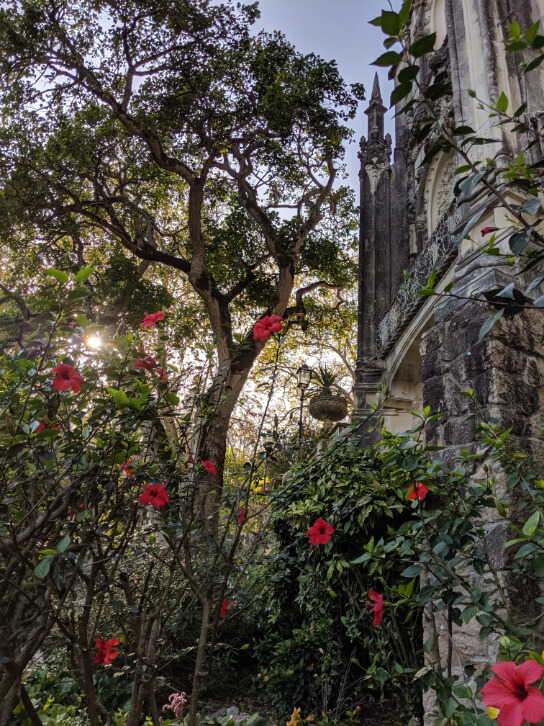
Want More?


